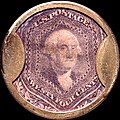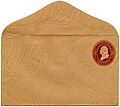Portal:Philately
| Philately portal | WikiProject Philately |
The Philately Portal
Philately is the study of revenue or postage stamps. This includes the design, production, and uses of stamps after they are issued. A postage stamp is evidence of pre-paying a fee for postal services. Postal history is the study of postal systems of the past. It includes the study of rates charged, routes followed, and special handling of letters.
Stamp collecting is the collecting of postage stamps and related objects, such as covers (envelopes, postcards or parcels with stamps affixed). It is one of the world's most popular hobbies, with estimates of the number of collectors ranging up to 20 million in the United States alone.
The Auberge d'Italie (Maltese: Berġa tal-Italja, Italian: Albergo d'Italia) is an auberge in Valletta, Malta. It was built in various stages in the late 16th century to house knights of the Order of Saint John from the langue of Italy, and it originally had a Mannerist design by Girolamo Cassar and several other architects. The building continued to be modified throughout the course of the 17th century, with the last major renovation being carried out in the 1680s during the magistracy of Gregorio Carafa, giving the building a Baroque character.
After the Order was expelled from Malta in 1798, the auberge was used for a number of purposes, housing a military headquarters, an officers' mess, a museum, a school of arts, a courthouse, the General Post Office and various government departments. Until recently, it housed the Malta Tourism Authority, and there are ongoing works of restoration. It is now converted to host the national collection (previously at National Museum of Fine Arts). In 2018 it became the new National Community Art Museum, MUŻA (from the Maltese acronym Mużew Nazzjonali tal-Arti). (Full article...)
Selected article -

issue of 1911
Postage stamps and postal history of the Canal Zone is a subject that covers the postal system, postage stamps used and mail sent to and from the Panama Canal Zone from 1904 up until October 1978, after the United States relinquished its authority of the Zone in compliance with the treaty it reached with Panama.
The Canal Zone was a strip of territory 50 miles (80 km) long and 10 miles (16 km) wide across the Isthmus of Panama, and was ceded to the United States for the purpose of constructing and operating the canal which connected the Atlantic and Pacific Oceans. Upon the establishment of the Canal Zone in 1903, seventeen Post Offices had also been established and were operated by the U.S. Government. The Canal Zone and its post offices, with the main distributing office in Cristobal, operated as an independent government agency under the direct authority of the President of the United States. In the towns where there were railroad stations, the station agents of the Panama Railroad functioned as postmasters. Along with ships and freight, domestic mail and mail from around the world moved through the canal. The Canal Zone Post Office began operating and issued its first postage stamps on June 24, 1904. Initially these were the current stamps of Panama or (less often) the U.S., overprinted with 'CANAL ZONE' in various styles. Philatelists have identified over 100 varieties, some of them quite rare (and counterfeited). (Full article...)
Selected images
Did you know (auto-generated)

- ... that James Diossa rescued the only public library and post office in Central Falls, Rhode Island, when the city went into bankruptcy?
- ... that Amrita Sher-Gil's painting Hill Women appeared on a 1978 Indian postage stamp?
- ... that after Irish post office clerk Maureen Flavin Sweeney reported worsening weather conditions, Dwight D. Eisenhower agreed to postpone D-Day by 24 hours?
- ... that working at a post office was how Derrick Harden became an NFL player?
General images -
Selected stamp -

The HMS Glasgow error is a 6d postage stamp error produced by the Falkland Islands in 1964. It commemorates the 50th anniversary of the 1914 Battle of the Falkland Islands.
The error featured the incorrect ship, HMS Glasgow, instead of HMS Kent, which should have been used. Apparently one sheet was sent to a stamp dealer in the United States who did not notice the mistake. It is believed that only the one sheet of 60 stamps was produced; only 17 stamps have been recorded. (Full article...)
List articles

- List of philatelists
- List of most expensive philatelic items
- List of postage stamps
- Lists of people on postage stamps (article) • (Category page)
- List of entities that have issued postage stamps (A–E)
- List of entities that have issued postage stamps (F–L)
- List of entities that have issued postage stamps (M–Z)
- List of postal services abroad
- Timeline of postal history
Related portals
Topics
Categories
WikiProject
![]() WikiProject Philately organizes the development of articles relating to philately. For those who want to skip ahead to the smaller articles, the WikiProject also maintains a list of articles in need of improvement or that need to be started. There are also many red inked topics that need to be started on the list of philatelic topics page.
WikiProject Philately organizes the development of articles relating to philately. For those who want to skip ahead to the smaller articles, the WikiProject also maintains a list of articles in need of improvement or that need to be started. There are also many red inked topics that need to be started on the list of philatelic topics page.
Selected works
- Williams, Louis N., & Williams, Maurice (1990). Fundamentals of Philately {revised ed.). American Philatelic Society. ISBN 0-9335-8013-4.
{{cite book}}: CS1 maint: multiple names: authors list (link) - Hornung, Otto (1970). The Illustrated Encyclopedia of Stamp Collecting. Hamlyn. ISBN 0-600-01797-4.
- Stuart Rossiter & John Fowler (1991). World History Stamp Atlas (reprint ed.). pub: Black Cat. ISBN 0-7481-0309-0.
{{cite book}}: CS1 maint: publisher location (link)
Wikimedia
The following Wikimedia Foundation sister projects provide more on this subject:
-
Commons
Free media repository -
Wikibooks
Free textbooks and manuals -
Wikidata
Free knowledge base -
Wikinews
Free-content news -
Wikiquote
Collection of quotations -
Wikisource
Free-content library -
Wikiversity
Free learning tools
Other Portals
Sources
- ^ "Philatelic Collections: General Collections". British Library. 2003-11-30. Archived from the original on 30 June 2011. Retrieved 2011-01-16.














![Image 11Unissued 1956 £1 Jamaican chocolate and violet, the first stamp designed for Queen Elizabeth II. Held in the British Library Crown Agents Collection.[1]](http://upload.wikimedia.org/wikipedia/commons/thumb/9/9b/Stamp_Jamaica_1956_unissued_1sh.jpg/120px-Stamp_Jamaica_1956_unissued_1sh.jpg)















































